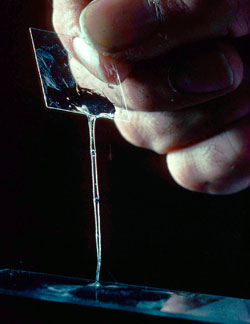
OVULATION INDUCTION (OI)
Ovulation, which is the release of an egg from the ovary is not always a regular and predictable event. In fact nearly 30% of infertility problems are due to defective or absent ovulation. The commonest cause of this is a condition called polycystic ovary syndrome where there is a major hormone imbalance which prevents the normal maturing of eggs. In most cases, by using fertility drugs such as clomifene, it can be relatively easy to stimulate eggs to grow to maturity and to ovulate. In other cases, even on treatment, ovulation either does not occur at all, is totally unpredictable, or other problems arise such as poor cervical mucus.
In these situations, it is often helpful to have a finer control of egg growth by administering fertility drugs by injection. These drugs are called gonadotrophins and contain purified human pituitary follicle stimulating hormone (FSH) either alone or in combination with luteinising hormone (LH). These hormones can either be natural or produced synthetically. The injections can be self-administered virtually painlessly and with the greatest of ease. The response of your ovaries to the injections is monitored with regular ultrasound scans. As long as no more than two eggs mature and become ready to ovulate, ovulation is induced with an injection of human chorionic gonadotrophin (hCG). You are then encouraged to have intercourse during the next few days.
Apart from the very exact control of ovulation, the other big advantage of gonadotrophin treatment is that the cervical mucus flows beautifully producing the so-called "ovulation cascade". This very favourable mucus gives the sperm very ready access to the cavity of the uterus unlike the tangled meshwork presented by hostile, inadequate and unfavourable mucus. Obviously the sperm count must be known to be normal and the fallopian tubes must be open and healthy.
The disadvantages of gonadotrophin treatment are that the ideal ovulation of just one mature egg does not always occur. If several eggs mature and ovulate there is a significant risk of a multiple pregnancy and very occasionally of a condition called ovarian hyperstimulation syndrome (OHSS) (see OHSS information). In OHSS there is enlargement of the ovaries and some abdominal distension and pain which very rarely may need in-patient hospital observation. Severe OHSS is exceedingly unlikely to occur in these cycles as such care is taken with the ultrasound tracking. Therefore, if more than two mature egg follicles are seen, the treatment cycle is abandoned and a new cycle of treatment is begun with the start of the next period. Although it will be disappointing and frustrating to have to abandon a cycle, common sense and safely must come first. If a pregnancy does not result within a few cycles, it may be recommended that your treatment should be upgraded to intrauterine insemination (IUI).
March 2009
